英语语法-状语从句
- 格式:ppt
- 大小:292.50 KB
- 文档页数:26
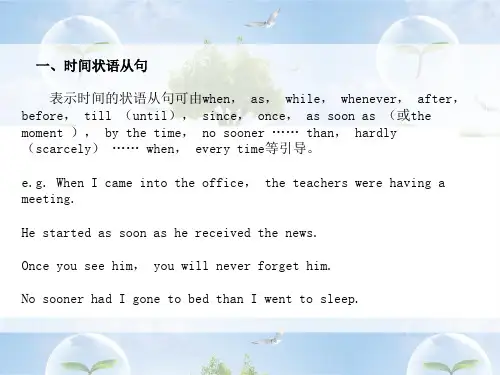

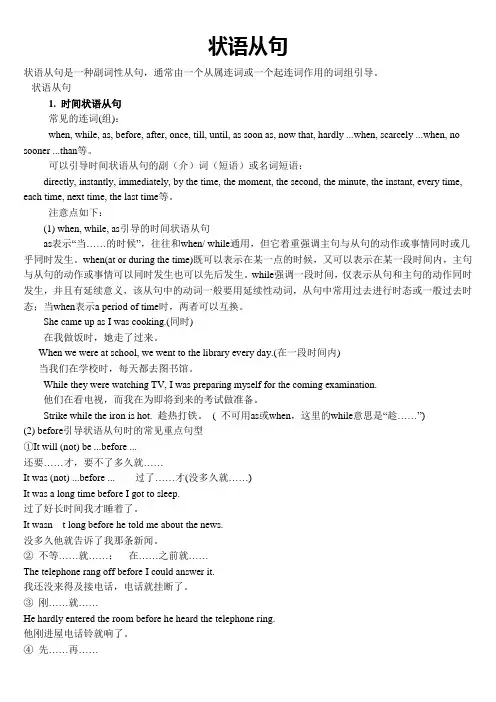
状语从句状语从句是一种副词性从句,通常由一个从属连词或一个起连词作用的词组引导。
状语从句1. 时间状语从句常见的连词(组):when, while, as, before, after, once, till, until, as soon as, now that, hardly ...when, scarcely ...when, no sooner ...than等。
可以引导时间状语从句的副(介)词(短语)或名词短语:directly, instantly, immediately, by the time, the moment, the second, the minute, the instant, every time, each time, next time, the last time等。
注意点如下:(1) when, while, as引导的时间状语从句as表示“当……的时候”,往往和when/ while通用,但它着重强调主句与从句的动作或事情同时或几乎同时发生。
when(at or during the time)既可以表示在某一点的时候,又可以表示在某一段时间内,主句与从句的动作或事情可以同时发生也可以先后发生。
while强调一段时间,仅表示从句和主句的动作同时发生,并且有延续意义,该从句中的动词一般要用延续性动词,从句中常用过去进行时态或一般过去时态;当when表示a period of time时,两者可以互换。
She came up as I was cooking.(同时)在我做饭时,她走了过来。
When we were at school, we went to the library every day.(在一段时间内)当我们在学校时,每天都去图书馆。
While they were watching TV, I was preparing myself for the coming examination.他们在看电视,而我在为即将到来的考试做准备。

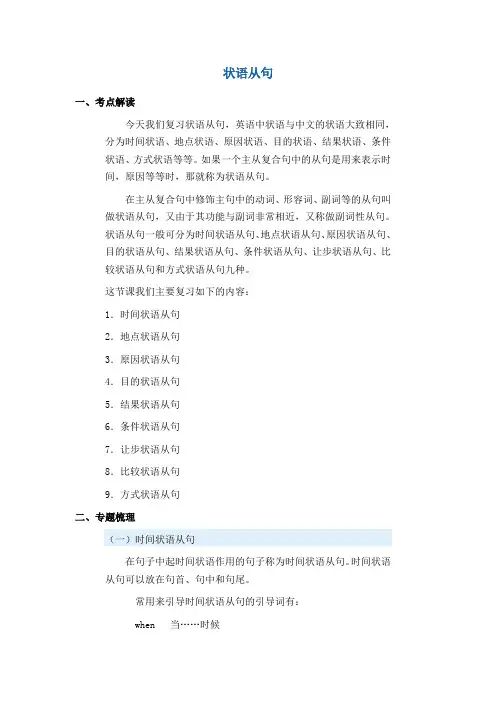
状语从句一、考点解读今天我们复习状语从句,英语中状语与中文的状语大致相同,分为时间状语、地点状语、原因状语、目的状语、结果状语、条件状语、方式状语等等。
如果一个主从复合句中的从句是用来表示时间,原因等等时,那就称为状语从句。
在主从复合句中修饰主句中的动词、形容词、副词等的从句叫做状语从句,又由于其功能与副词非常相近,又称做副词性从句。
状语从句一般可分为时间状语从句、地点状语从句、原因状语从句、目的状语从句、结果状语从句、条件状语从句、让步状语从句、比较状语从句和方式状语从句九种。
这节课我们主要复习如下的内容:1.时间状语从句2.地点状语从句3.原因状语从句4.目的状语从句5.结果状语从句6.条件状语从句7.让步状语从句8.比较状语从句9.方式状语从句二、专题梳理(一)时间状语从句在句子中起时间状语作用的句子称为时间状语从句。
时间状语从句可以放在句首、句中和句尾。
常用来引导时间状语从句的引导词有:when 当……时候while 当……时候as 当……时候、一边after 在……之后before 在……之前since 自从ever since 自从once 一……就……whenever 不管什么时候by the time 到……as long as 长达……as soon as 一……就……till/until 直到……1.when,while,as的用法从属连词when,while,as都可用来引导时间状语从句,意为“在……时候”。
但在具体用法上又不尽相同。
(1)这三个连词中,when用得最广,常可代替while与as。
与while相比,when引导的从句动词既可是延续性的,也可是终止性的。
as在这一点上与when相同,while所引导的从句中,动词只能是延续性的。
在初中阶段,我们几乎很少讲as引导时间状语从句。
是因为as在初中阶段是一种供了解性的内容。
e.g.When the fire broke out, all the studentswere sleeping soundly.(终止性的)当火灾发生时,所有的学生正在熟睡中。
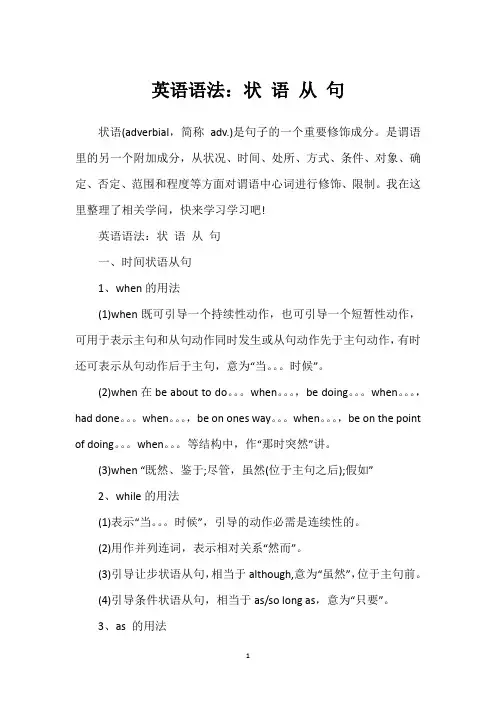
英语语法:状语从句状语(adverbial,简称adv.)是句子的一个重要修饰成分。
是谓语里的另一个附加成分,从状况、时间、处所、方式、条件、对象、确定、否定、范围和程度等方面对谓语中心词进行修饰、限制。
我在这里整理了相关学问,快来学习学习吧!英语语法:状语从句一、时间状语从句1、when的用法(1)when既可引导一个持续性动作,也可引导一个短暂性动作,可用于表示主句和从句动作同时发生或从句动作先于主句动作,有时还可表示从句动作后于主句,意为“当。
时候”。
(2)when在be about to do。
when。
,be doing。
when。
,had done。
when。
,be on ones way。
when。
,be on the point of doing。
when。
等结构中,作“那时突然”讲。
(3)when “既然、鉴于;尽管,虽然(位于主句之后);假如”2、while的用法(1)表示“当。
时候”,引导的动作必需是连续性的。
(2)用作并列连词,表示相对关系“然而”。
(3)引导让步状语从句,相当于although,意为“虽然”,位于主句前。
(4)引导条件状语从句,相当于as/so long as,意为“只要”。
3、as 的用法(1)表示“当。
时候”,强调同时发生,不指先后。
(2)说明两种正在进展或变化的状况,表示“随着”,表示时间的推移。
(3)表示“一边。
一边。
”。
(4)强调两个动作紧接着发生。
(5)表示“虽然,尽管”。
(6)其他含义“正如,正像”,“作为”,“由于,由于”。
4、before的用法(1)一般意为“在。
之前”“。
才”,“。
就”“还没有。
”“免得”“不知不觉”“宁可,宁愿”,“否则,要不然”。
(2)It + will be/was + 时间段+before+一般现在时/一般过去时。
在确定句中,意为“多长时间之后才”;在否定句中,意为“用不了多长时间就”。
5、until和till(1)与确定句连用,必需是连续性动词。
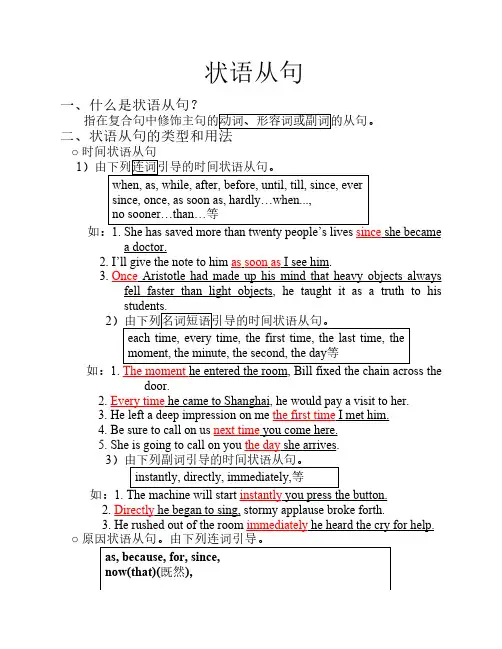
状语从句一、什么是状语从句?指在复合句中修饰主句的动词、形容词或副词的从句。
二、状语从句的类型和用法○ 时间状语从句1)由下列连词引导的时间状语从句。
when, as, while, after, before, until, till, since, eversince, once, as soon as, hardly…when...,no sooner…than…等如:1. She has saved more than twenty people’s lives since she becamea doctor.2. I’ll give the note to him as soon as I see him.3. Once Aristotle had made up his mind that heavy objects alwaysfell faster than light objects, he taught it as a truth to hisstudents.2)由下列名词短语引导的时间状语从句。
each time, every time, the first time, the last time, themoment, the minute, the second, the day等如:1. The moment he entered the room, Bill fixed the chain across the door.2. Every time he came to Shanghai, he would pay a visit to her.3. He left a deep impression on me the first time I met him.4. Be sure to call on us next time you come here.5. She is going to call on you the day she arrives.3)由下列副词引导的时间状语从句。
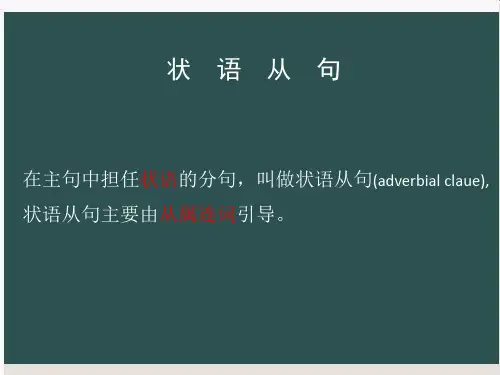
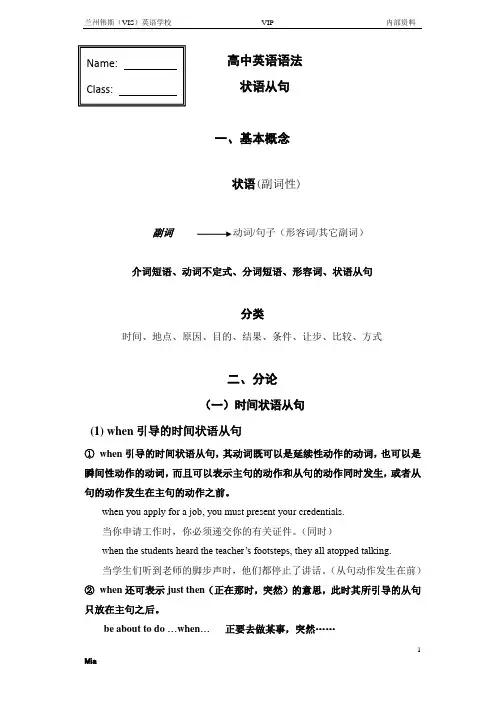
高中英语语法状语从句一、基本概念状语(副词性)副词 动词/句子(形容词/其它副词)介词短语、动词不定式、分词短语、形容词、状语从句分类时间、地点、原因、目的、结果、条件、让步、比较、方式二、分论(一)时间状语从句(1) when 引导的时间状语从句①when 引导的时间状语从句,其动词既可以是延续性动作的动词,也可以是瞬间性动作的动词,而且可以表示主句的动作和从句的动作同时发生,或者从句的动作发生在主句的动作之前。
when you apply for a job, you must present your credentials.当你申请工作时,你必须递交你的有关证件。
(同时)when the students heard the teacher’s footsteps, they all atopped talking.当学生们听到老师的脚步声时,他们都停止了讲话。
(从句动作发生在前) ② when 还可表示just then (正在那时,突然)的意思,此时其所引导的从句只放在主句之后。
be about to do …when … 正要去做某事,突然……be doing …when…正在做某事,突然……be on the point of doing …when…正在做某事,突然……We were about to start when it began to rain.我们正要动身,突然天下起雨来。
The game had hardly/scarcely/barely begun when it started raining.比赛刚刚开始就下起雨来。
(2) as引导的时间状语从句as引导的时间状语从句其动词的动作是延续性的,而且侧重表示主句和从句的动作交替或同时发生,译为“一边……,一边……”或“随着……”We were having breakfast as she was combing her hair.她梳头时我们在吃早饭。

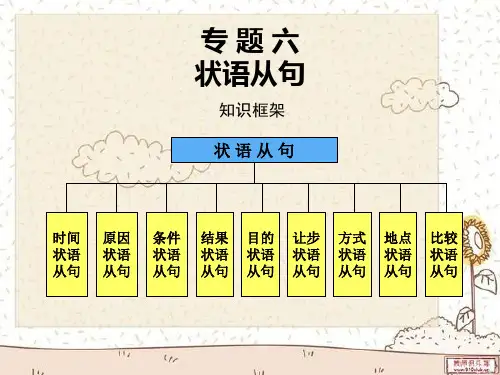
英语语法----状语从句一、时间状语从句1、常用引导词:when, as, while, as soon as, before, after, till/until, since,whenever2、特殊引导词:the minute,the moment, the second, every time, the day, theinstant, instantly, immediately, directly, no sooner …than, hardly …when, scarely…when.除了“the day”翻译为“那一天”,其他的都翻译为“一…就…”3、had no sooner /hardly/scarely +done…than/when/when+did4、while 从句谓语动词要求是延续性动词5、when 从句谓语动词是延续性动词和瞬间动词都可以6、till=until, till不能用于句首,until可以用于句首。
:主句 Not+瞬间动词,从句until+延续性动词:译为“直到…才…”例句:Don’t get off the bus until it has stopped.He waited for his father until(=till) it was twelve o’clock.7、directly, immediately, the moment, the minute that, instantly: “一….就…”He made for the door directly he heard the knock.他一听到敲门就过去了。
Make for+目的地;leave for+目的地;set for+目的地8、each time =every time 每当By the time:到…时候`by the time+现在时,主句谓语动词用将来完成时(will have done)9、“It is ……since/before/when/that”句型It is + 段时间+since (+瞬间动词表示:从开始到现在;+延续性动词表示:从结束到现在)It has been +段时间+sinceIt was +段时间+before(译为“过了多久才某事”)It will be +段时间+before(译为“还有多久就做某事”)It is/was+点时间+when(译为“当做某事的时候是几点”).It is /was +时间状语+that(强调句)例句:It is three years since I smoked. 译为“我戒烟3年了。
一,状语从句状语从句在主从复合句中修饰主句中的动词、形容词或副词等,起副词的作用。
状语从句由从属连词引导,从属连词在从句中不担任任何句子成分。
状语从句可位于主句之前,也可位于主句之后。
位于主句之前,一般要加逗号与主句分开;位于句末则不需要。
状语从句根据它所表达的意思可分为时间、地点、原因、目的、结果、比较,让步、方式和条件状语从句等类。
(一),时间状语从句引导时间状语从句的从属连词有:when, while, as soon as, before, after, since , till, until 等【注】1,until (till) 直到,在用until 表达时间状语的句子中,主句中的动词是要十分小心去选择。
如动词是持续性动词,它要用肯定句,如:I studied hard until 12 o'clock last night. 如果动词是瞬间截止性动词,则要用否定句,即,not---until “直到…才”。
如:He didn't go to bed until his mother came back.They didn’t stop until they finished t he work .2,时间状语从句中的谓语动词不能用,将来时,终能用一般现在时表示一般将来时,即“主将从现”原则。
如,When he comes, I’ll tell him about it.I will call you as soon as I arrive in Beijing. 我到北京就将给你打电话(二),条件状语从句通常由从属连词if,unless等引导【注】1,条件状语从句与时间状语从句一样,从句中不能用将来时态,要用一般现在时态表示一般将来时态,也符合“主将从现”原则。
如,If it snows tomorrow, we will build a snowman.If it rains, they won't go to the park on SundayI won’t go to his party unless I am invited .,2,要区别是条件、时间状语从句还是宾语从句,因为在宾语从句中该用什么时态用什么时态,如:I want to know if he will come here tomorrowI want to know if it will rain tomorrow. If it doesn’t rain, I will go hiking.I don’t know when he will come, When he comes, I’ll tell him about it.(三),让步状语从句通常由从属连词though(although)(虽然,尽管),even if(even though)(即使)等引导注:翻译是后半句带有转折的意味,但不能由but连接。
状语从句状语从句用来修饰主句中的动词,副词和形容词的从句叫状语从句。
根据其含义状语从句可分为时间状语从句,地点状语从句,条件状语从句,原因状语从句,结果状语从句,比较状语从句,目的状语从句,让步状语从句。
1. 时间状语从句(1)时间状语从句常用when, as, while, before, after, since, till, until, as soon as等连词来引导。
例如:It was raining hard(rain hard 下大雨)when got to school yesterday.While he was doing his homework, the telephone rang.As he walked along(沿着走)the lake, he sang happily.He had learned a little Chinese before he came to China.After he finished middle school, he went to work in a factory.(2)在时间状语从句里,通常不用将来时态,用现在时态表示将来的动作或状态。
例如:I’ll ring you up as soon as I get to New York.I will tell him everything when he comes back.He won’t believe it until he sees it with his own eyes.(3)在带有till或until引导的时间状语从句的主从复合句里,如果主句用肯定式,其含义是“一直到……时”,谓语动词只能用延续性动词。
如果主句用否定式,其含义是“直到……才……”, “在……以前不……”, 谓语动词可用瞬间动词。
例如:The young man read till the light went out(熄灭).Let’s wait until the rain stops.We won’t start until Bob comes.Don’t get off(从下来)until the bus stops.【Till是指直到某一特定事件发生的时候,而在那个时刻之后,该事情或状况仍将持续。